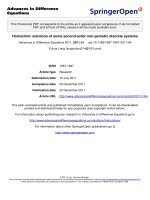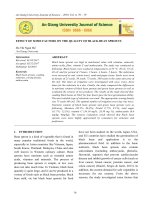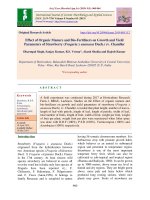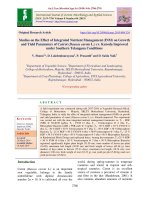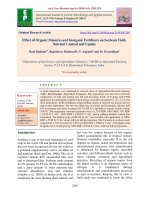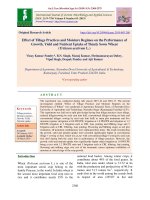Effect of organic extracted nutrient solution on growth, yield of some leaf vegetables on vertical aquaponics system
Bạn đang xem bản rút gọn của tài liệu. Xem và tải ngay bản đầy đủ của tài liệu tại đây (2.5 MB, 105 trang )
VIETNAM NATIONAL UNIVERSITY OF AGRICULTURE
FACULTY OF AGRONOMY
---------------------------------------------------
UNDERGRADUATE THESIS
TITLE:
EFFECT OF ORGANIC EXTRACTED NUTRIENT
SOLUTION ON GROWTH, YIELD OF SOME LEAF
VEGETABLES ON VERTICAL AQUAPONICS
SYSTEM
STUDENT
:
PHAN NHAT THANH
STUDENT CODE : 613091
INSTRUCTOR
CLASS: K61KHCTT
: Dr. NGUYEN THI AI NGHIA
DEPARTMENT OF EXPERIMENTAL METHODS & BIOLOGY
STATISTICS
HANOI - 2021
REASSURANCES
I hereby declare that the data and research results presented in this
thesis are completely honest and objective, made on the basis of theoretical
research, specialized knowledge, actual survey research. Any assistance in the
implementation of this thesis is appreciated and the information cited in the
thesis is clearly traced.
Hanoi, February 24, 2021
Student
Phan Nhat Thanh
i
ACKNOWLEGEMENTS
To complete this thesis, I am deeply indebted to many people for their
advice, instruction and support.
First and foremost, I would like to send my gratitude to my instructor,
Dr. Nguyen Thi Ai Nghia, Department of Experimental Methods & Biology
Statistics, Faculty of Agronomy, Vietnam National University of Agriculture,
for her enthusiastic support, helpful advice and considerable encouragement
in the completion of my thesis.
I would also like to give my gratitude to my teachers who gave me the
necessary knowledge and skills during my time here. Especially I would also
like to give my gratitude to all of my teachers in faculty of Agronomy and
Center for Organic Agriculture Promotion and Studies.
In addition, I would like to acknowledge my family, who always stood
by me, for their in conditional love and support, both financially and
emotionally throughout my work.
Save the best for last, I want to express my thanks to my friends in
Vietnam National University of Agriculture for their friendship and support.
Hanoi, February 24, 2021
Student
Phan Nhat Thanh
ii
CONTENTS
REASSURANCES ............................................................................................ i
ACKNOWLEGEMENTS ................................................................................ ii
CONTENTS .................................................................................................... iii
LIST OF ACRONYMS................................................................................... vi
LIST OF TABLES ......................................................................................... vii
LIST OF FIGURES......................................................................................... ix
ABSTRACT ..................................................................................................... x
Chapter I INTRODUCTION............................................................................ 1
1.1.
Introduction ........................................................................................ 1
1.2.
Objectives and requirements .............................................................. 2
1.2.1.
Objectives........................................................................................... 2
1.2.2.
Requirements ..................................................................................... 2
1.3.
Research scope ................................................................................... 3
1.4.
New contributions, the scientific or practical significance of the
topic .................................................................................................... 3
1.4.1.
New contributions of the topic........................................................... 3
1.4.2.
The scientific or practical significance of the topic ........................... 3
Chapter II LITERATURE REVIEW ............................................................... 4
2.1.
Overview of the aquaponics system .................................................. 4
2.1.1.
The definition of aquaponics system ................................................. 4
2.1.2.
Several popular aquaponics systems in the world ............................. 9
2.2.
Vertical aquaponics system ............................................................. 10
2.2.1.
Vertical farming ............................................................................... 10
2.2.2.
Vertical aquaponics .......................................................................... 11
2.3.
Introduction to the water spinach, loose leaf lettuce and leaf
mustard ............................................................................................. 13
iii
2.3.1.
Water spinach................................................................................... 13
2.3.2.
Loose Leaf lettuce ............................................................................ 15
2.3.3.
Leaf mustard .................................................................................... 17
2.4.
Organic nutrient solution is extracted from animal and plant
materials ........................................................................................... 18
2.4.1.
Nutritional supplements for aquaponics .......................................... 18
2.4.2.
Extraction process ............................................................................ 19
2.4.3.
The effectiveness of organics nutrient solution ............................... 19
2.5.
Some research articles on aquaponics system ................................. 20
Chapter III MATERIAL AND METHOD..................................................... 24
3.1.
Object and Material.......................................................................... 24
3.1.1.
Object ............................................................................................... 24
3.2.
Place and time .................................................................................. 25
3.3.
Research contents............................................................................. 25
3.4.
Methods ............................................................................................ 26
3.4.1.
Research methods. ........................................................................... 26
3.4.2.
Technical application ....................................................................... 27
3.5.
Characteristics .................................................................................. 27
3.6.
Data analysis .................................................................................... 28
Chapter IV RESULTS AND DISCUSSION ................................................. 29
4.1.
Results of environmental factors during the research period .......... 29
4.1.1.
The pH.............................................................................................. 29
4.1.2.
TDS concentrations .......................................................................... 30
4.2.
Effect of organic extracted nutrient solution concentration on
growth characteristics and physiologic characteristics of water
spinach. ............................................................................................ 31
4.2.1.
Effect of organic extracted nutrient solution concentration on
growth characteristics of water spinach. .......................................... 31
iv
4.2.2.
Effect of organic extracted nutrient solution concentration on
SPAD index, Brix value and leaf area of water spinach. ................ 36
4.2.3.
Effect of organic extracted nutrient solution concentration on
the yield of water spinach. ............................................................... 38
4.3.
Effect of organic extracted nutrient solution concentration on
growth characteristics and physiologic characteristics of loose
leaf lettuce. ....................................................................................... 39
4.3.1.
Effect of organic extracted nutrient solution concentration on
growth characteristics of loose leaf lettuce. ..................................... 39
4.3.2.
Effect of organic extracted nutrient solution concentration on
SPAD index, Brix value and leaf area of loose leaf lettuce.. .......... 43
4.3.3.
Effect of organic extracted nutrient solution concentration on
the yield of loose leaf lettuce. .......................................................... 45
4.4.
Effect of organic extracted nutrient solution concentration on
growth characteristics and physiologic characteristics of leaf
mustard. ............................................................................................ 46
4.4.1.
Effect of organic extracted nutrient solution concentration on
growth characteristics of leaf mustard. ............................................ 46
4.4.2.
Effect of organic extracted nutrient solution concentration on
SPAD index, Brix value and leaf area of leaf mustard. ................... 49
4.4.3.
Effect of organic extracted nutrient solution concentration on
the yield of leaf mustard. ................................................................. 52
4.5.
Revenues and profits of the aquaponics system .............................. 53
Chapter V CONCLUSIONS AND SUGGESTIONS ................................... 56
5.1.
Conclusions ...................................................................................... 56
5.2
Suggestions ...................................................................................... 57
REFERENCES ............................................................................................... 58
v
LIST OF ACRONYMS
AP
Aquaponics production
Brix
Sugar content of an aqueous solution
DPT
Days post-transplant
DWC
Deep water culture
NFT
Nutrient Film Technique
PSDR-LIPI
Regional Resources Research Center - Institute of
Science Indonesian knowledge
RAS
Recirculating aquaculture system
SPAD
Measure specific to chlorophyll content in plant leaves
TDS
Totals dissolved solids
vi
LIST OF TABLES
Table 2.1. Nutritional ingredients are in the original organic nutrient
solution ............................................................................................................... 19
Table 4.1. The pH variation in the fish tank .............................................................. 30
Table 4.2. The TDS variation in the fish tank (g/L) ............................................... 31
Table 4.3. Effect of organics nutrient solution concentration on water
spinach height.................................................................................................. 32
Table 4.4. Effect of organics nutrient solution concentration on number
of leaves of water spinach .......................................................................... 34
Table 4.5. Effect of organics nutrient solution concentration on SPAD
index of water spinach ................................................................................. 36
Table 4.6. Effect of organics nutrient solution concentration on Brix
value and leaf area of water spinach ...................................................... 37
Table 4.7. Effects of organics nutrient solution on some indicators of
yield and product quality ............................................................................ 39
Table 4.8. The effect of organics nutrient solution concentration on
loose leaf lettuce height ............................................................................... 40
Table 4.9. Effect of organics nutrient solution concentration on number
of leaves of loose leaf lettuce .................................................................... 42
Table 4.10. Effect of organics nutrient solution concentration on SPAD
index of loose leaf lettuce........................................................................... 43
Table 4.11. Effect of organics nutrient solution concentration on Brix
value and leaf area of loose leaf lettuce ................................................ 44
Table 4.12. Effects of organics nutrient solution on some indicators of
yield and product quality ............................................................................ 45
Table 4.13. The effect of organics nutrient solution concentration on leaf
mustard height ................................................................................................. 47
vii
Table 4.14. The effect of organics nutrient solution concentration on
number of leaf of leaf mustard ................................................................. 48
Table 4.15. Effect of nutrient solution concentration on SPAD index of
leaf mustard ...................................................................................................... 50
Table 4.16. Effect of organics nutrient solution concentration on Brix
value and leaf area of leaf mustard ......................................................... 51
Table 4.17. Effects of organics nutrient solution on some indicators of
yield and product quality ............................................................................ 53
Table 4.18. The revenue and profits of aquaponics system .................................. 54
viii
LIST OF FIGURES
Fig 2.1.
The model illustrates the working principle of the vertical
Aquaponics system ........................................................................................... 12
Fig 2.2.
The number of papers published on ‘Hydroponics’,
‘Recirculating aquaculture system’(RAS) and ‘Aquaponics’
from 1980 to 2018 (data were collected from the Scopus
database on 30 January 2019) (Goddek et al, 2019) ........................... 21
Fig 4.1.
Height growth of water spinach in the experiment .............................. 33
Fig 4.2.
Effect of organics nutrient solution concentration on number
of leaves of water spinach.............................................................................. 35
Fig 4.3.
SPAD index, brix value and leaf area of water spinach at the
day of harvest ...................................................................................................... 37
Fig 4.4.
The effect of organics nutrient solution concentration on loose
leaf lettuce height .............................................................................................. 40
Fig 4.5.
Effect of organics nutrient solution concentration on number
of leaves of loose leaf lettuce ....................................................................... 42
Fig 4.6.
SPAD index, brix value and leaf area of loose leaf lettuce at
the day of harvest .............................................................................................. 44
Fig 4.7.
The effect of organics nutrient solution concentration ...................... 47
Fig 4.8.
The effect of organics nutrient solution concentration on
number of leaf of leaf mustard ..................................................................... 49
Fig 4.9.
Effect of organics nutrient solution concentration on Brix
value, leaf area and SPAD index of leaf mustard ................................ 51
ix
ABSTRACT
This study was conducted to determine the effects of four organic
extracted nutrient solution concentrations (0%, 1%, 2%, 3%) as foliar
fertilizers, on water spinach, loose leaf lettuce and leaf mustard grown in
vertical aquaponics system. The organic nutrient solution is extracted from
animal and plant materials like fish, water spinach, wormwood, banana stem,
banana, papaya, animal bone ash, sesame ash. The experiment was conducted
on a vertical aquaponics system with 12 hollow plastic pillars (15 growing
media/pillar). The pillars were laid out in a randomized complete block
design with three replications. Anabas fish are fed in fish tank. The results
showed that organic nutrient solution extracted from plants and animals to
grow plants in the aquaponics system gives a positive effect on yield and
quality of water spinach, loose leaf lettuce and leaf mustard in which
concentrations of 3% yielded highest yield. Organic extracted nutrient
solution treatments showed higher quality compared with control treatment.
Economic efficiency on three leaf vegetables reached the highest value at two
concentrations 2 and 3% organics extracted nutrient solution. The results
suggested that 3 varieties of leaf vegetables give the best performance in
overall 3 criteria of quality, productivity and economy at organic extracted
nutrient solution concentration of 2%.
x
Chapter I
INTRODUCTION
1.1. Introduction
Vegetables are essential food for human life, provide most minerals and
vitamins, contribute to nutritional balance in daily meals. On the market
today, there are many types of vegetables grown by different methods,
leading to many unsafe products due to overuse of agricultural chemicals.
Therefore, safe vegetable and organic vegetable products are an urgent issue
in the market.
One of the solutions to have a source of fresh vegetables, fresh fish in
households and apartment complexes in big cities is to grow vegetables using
substrates, grow aquaponics. Current practice shows that, growing hydroponic
vegetables mainly uses chemical solutions, so the quality of the product is not
guaranteed, the cost is high and the producers do not like to use it. According
to Pham Tien Dung (2012), in research on organic production of vegetables
and rice, all organic nutrients are used through leaves extracted from animals,
plants, and plants. This has been shown to be effective on crops.
Aquaponics is a bio-integrated system that links recirculating
aquaculture with hydroponic vegetable, flower, and/or herb production.
Recent advances by researchers and growers alike have turned aquaponics
into a working model of sustainable food production. Aquaponics serves as a
model of sustainable food production by following certain principles:
- The waste products of one biological system serve as nutrients for a
second biological system.
- The integration of fish and plants results in a polyculture that increases
diversity and yields multiple products.
- Water is re-used through biological filtration and recirculation.
1
-
Local food production provides access to healthy foods and enhances
the local economy
In aquaponics, nutrient-rich effluent from fish tanks is used to fertigate
hydroponic production beds. This is good for the fish because plant roots and
rhizobacteria remove nutrients from the water. These nutrients generated from
fish manure, algae, and decomposing fish feed are contaminants that would
otherwise build up to toxic levels in the fish tanks, but instead serve as liquid
fertilizer to hydroponically grown plants. In turn, the hydroponic beds
function as a biofilter stripping off ammonia, nitrates, nitrites, and phosphorus
so the freshly cleansed water can then be recirculated back into the fish tanks.
The nutrient concentrations supplied by the fish in aquaponics system
are significantly lower for most nutrients, compared to hydroponic systems.
Requiring nutrient supplements based on organic substances will be most
beneficial. However, protocols for the application of such nutrient
amendments still need to be developed (András et al, 2016).
Following the fact mentioned above, the experiment was carried out:
“Effect of organic extracted nutrient solutions on growth, yield of some leaf
vegetables on vertical aquaponics system”
1.2. Objectives and requirements
1.2.1. Objectives
Determine the concentration of organic extracted nutrient solutions
suitable for each leaf vegetable.
1.2.2. Requirements
- Evaluating the effects of organic extracted nutrient solutions on the
growth and physiology of water spinach, loose leaf lettuce and leaf mustard.
- Evaluating the effects of organic extracted nutrient solutions on the
yield and quality of water spinach, loose leaf lettuce and leaf mustard.
2
- Evaluating the economic efficiency of using vertical aquaponics
system with organic extracted nutrient solutions.
1.3. Research scope
The subject was studied on water spinach, loose leaf lettuce and leaf
mustard grown on vertical Aquaponics system at the Center for Organic
Agriculture Promotion and Studies
1.4. New contributions, the scientific or practical significance of the topic
1.4.1. New contributions of the topic
Determine the effectiveness of the appropriate spray concentration of
the nutrient solution on the growth and yield of water spinach, loose leaf
lettuce and leaf mustard on vertical aquaponics system.
1.4.2. The scientific or practical significance of the topic
- Aquaponics system uses plant posts made from plastic bottles to
protect the environment, save production costs and increase farming area.
- Research results of the topic contribute to increasing productivity for
water spinach, loose leaf lettuce and leaf mustard.
3
Chapter II
LITERATURE REVIEW
2.1. Overview of the aquaponics system
2.1.1. The definition of aquaponics system
* The history of aquaponics system
Aquaponics is currently picking up steam as a sustainable, modern
farming method that can be done even with limited space. Today, while
growing fish and crops together may seem like a totally new innovation in the
farming industry, the technique has actually been in practice for many
centuries. According to Campbells (2020), the history of aquaponics traces
back to around 1000 AD, to a time when ancient peoples found a way to grow
food while keeping in mind the natural relationship of fish and animals.
Amongst scholars, there has been an ongoing debate regarding when
aquaponics was first introduced as an agricultural vehicle. The earliest
concept is believed to have started in 1000 AD among ancient Aztecs in
central Mexico. At that time, these people did not have the space to grow their
own food since their settlement is located on the shores of the freshwater lake,
Lake Texcoco. The area, particularly made up of marshlands with rough soil,
was not conducive to farming. To be able to grow food for the population, the
Aztecs came up with the concept of floating gardens called “chinampas.”
These gardens were created by piling up decayed plants and mud into
stationary islands. On top of it, farmers would sow crop seeds like maize,
squash, and tomatoes. The floating gardens grew healthy as they get their
nutrients from the lake waters. It’s worth noting that while aquaponics is not
as widely practiced as traditional organic farming methods, the history of
aquaponics shows that this concept has been around for a long time.
Generally, this concept displays the symbiotic relationship between fish and
4
plants and how it can be replicated to be used in commercial or home-based
systems. And because there’s a natural relationship between plants and fish,
aquaponics is considered a safe system for the environment. More research is
being done to design a more efficient aquaponics system, as this technique
shows so much potential to become the future of eco-farming. With the many
benefits of aquaponics, it continues to become an attractive industrial farming
alternative for many people around the world.
There are many definitions of aquaponics systems. According to Keith
Wiebe et al (2019), Aquaponics is a symbiotic integration of two food
production disciplines: (1) aquaculture, the practice of farming aquatic
organisms; and (2) hydroponics, the cultivation of plants in water without
soil. Aquaponics combines the two within a closed recirculating system. A
standard recirculating aquaculture system filters and removes the organic
matter (“waste”) that builds up in the water, keeping the water clean for the
fish. However, an aquaponics system filters the nutrient-rich effluent through
an inert substrate containing plants. Here, bacteria metabolize the fish waste
and plants assimilate the resulting nutrients, with the purified water then
returning to the fish tanks. The result is value-added products such as fish and
vegetables as well as lower nutrient pollution into watersheds.
* The potential of the aquaponics system.
Indonesia has developed a particular type of aquaponics, known as
Yumina–Bumina, that has been adopted in many districts. Yumina–Bumina
uses simple and locally available materials, and has proved to be an efficient
and low-energy demanding system with which to build resilience and selfsufficiency in single households or communities and to provide effective diet
diversification. Aquaponics has the potential for higher yields of produce and
protein with less labor, less land, and fewer chemicals, and takes up a fraction
5
of the water usage. Being a strictly controlled system, it combines a high level
of biosecurity with a low risk of disease and external contamination without
the need for fertilizers and pesticides. Moreover, it is a potentially useful tool
for overcoming some of the challenges of traditional agriculture in the face of
freshwater shortages, climate change, and soil degradation. Aquaponics works
well in places where the soil is poor and water is scarce, for example, in urban
areas, arid climates, and on low-lying islands. (Keith Wiebe, 2019). However,
commercial aquaponics is not appropriate in all locations, and many start-ups
have failed. Before investing in large-scale systems, operators need to
consider several factors carefully, especially the availability and affordability
of inputs (i.e., fish feed, building, and plumbing supplies), the cost and
reliability of electricity, and access to a significant market willing to pay
premium prices for locally produced, pesticide-free vegetables. Aquaponics
combines the risks of both aquaculture and hydroponics, and thus expert
assessment and consultation are essential.
* The sustainability of the aquaponics system.
Aquaponics is a completely natural process that mimics all lakes,
ponds, rivers and waterways on Earth. The only input into an aquaponics
system is fish food. The fish eat the food and excrete waste, which is
converted by beneficial bacteria to nutrients that the plants can use. In
consuming these nutrients, the plants help to purify the water. You cannot use
herbicides, pesticides or other harsh chemicals in an aquaponics system,
making the fish and plants healthful and safe to eat.
* The advantages of the aquaponics system.
6
According to Adam Travis (2018), Aquaponics considered a
sustainable production system. It presents a series of beneficial features for
the environment. Some of the advantages are the following:
- Land Conservation: Aquaponics system produces 2-6 times because it
allows to use multiple platforms on top of each other.
- Efficient use of water and nutrients: In aquaponic systems, water is a
well-used resource. It is the means of life of the fish and the roots of the
plants. That is water used twice better yet. The nitrified water from the fish
waste the plants cleaned to a certain extent. In this way, the soil does not
salinize in case of having to empty it.
- Organic fertilization: Fish waste is a nutrient-rich fertilizer for plants.
In this way, it is possible to reduce considerably the expense of fertilizer salts.
Better still, some of the certifications to organic products can overcome. If an
adequate management of the aquaponics system is carried out.
- Produce the highest yield on a field: You probably know from
aquaponics description that it can use the same land for production agriculture
and fishes. That means it can provide the highest yield on your land.
- No floor is required: In many places, the quality of the soil is poor.
That prevents the harvesting of good quality products. Aquaponics represents
an interesting alternative for areas. That is with soil problems and for desert
areas. It is also a system could be of great interest to cultivate in cities. The
somewhere arable land is practically non-existent.
- Environmental Benefits: Aquaponics uses 90% less water than
conventional agriculture. Being a closed system it does not waste river water
due to use of harmful fertilizer. This is more environment-friendly then
7
organic farming. Because it does not allow us to practice any harmful
farming.
-Closeness to the markets: An aquaponic system can be installed almost
anywhere. It is including food distribution centers and markets. In this way, it
would be possible to reduce expenses for transport concepts. It would have
fresher and better quality products. It could be without avoiding post-harvest
damage during transport.
* The disadvantages of aquaponics system
Like any productive system, aquaponics also has certain disadvantages.
The magnitude of these depends a lot on the care. That gives to each detail
some may be:
-Unsecured success: We know that no productive system has a perfect
success rate. In the case of aquaponics, the percentage is quite small. The
point is that many systems are largely standardized. On hydroponics, for
example, there is much information about it. With aquaponics is not the same,
much research and standardization are lacking.
-Multiple points of failure: Aquaponics is relatively more complex than
other production systems. Due to the fact, you have to be aware of both plants
and animals. This implies that the points where the system can fail are more.
On the one hand, the fish can die if they do not have the right conditions. On
the other hands, the plants are susceptible to pathogens.
- The initial cost to set up the aquaponics: Starting an aquaponics
project has a relatively higher initial cost than other production methods, such
as home gardens. However, it is not possible to give a real figure. It will
depend on the size of the system and its technological level. Consider that
pumps and plumbing items are required.
8
2.1.2. Several popular aquaponics systems in the world
- Deep water culture (DWC): or raft based growing uses a foam raft
that is floating in a channel filled with fish effluent water that has been
filtered to remove solid wastes. Plants are placed in holes in the raft and the
roots dangle freely in the water. This method is most appropriate for growing
salad greens and other fast-growing, relatively low-nutrient plants. It is also
most commonly used in larger commercial-scale systems.
- Media-based Aquaponics: Media growing involves growing plants in
inert planting media such as expanded clay pellets or shale. The media
provides both the biological filtration (conversion of ammonia to nitrates) and
mechanical filtration (removal of solid wastes) in the same system. Mediabased systems are great for home and hobby scale systems so you can grow a
wide variety of crops. In particular, large fruiting plants do really well in
addition to leafy greens, herbs and other varieties.
- Nutrient Film Technique (NFT): NFT systems work by flowing
nutrient-rich water through a narrow trough, such as a PVC pipe. Plants are
placed in holes drilled in this pipe, and the roots dangle freely in this stream
of water. This method of growing works very well for plants that need little
support, such as strawberries and other herbs. NFT is also a great way to
utilize unused space because they can be hung from ceilings above other
growing areas.
- Vertical Aquaponics: One of the greatest aspects of aquaponics is its
ability to grow an incredible amount of food in a very small area. No method
does this better than vertical aquaponics. Plants are stacked on top of each
other in tower systems such as the AquaVertica. Water flows in through the
9
top of the tower, and flows through a wicking material that the plants roots
absorb water and nutrients from. The water then falls into a trough or directly
into the fish tank. This form of agriculture makes the most of each square
foot of space, and works very well with leafy greens, strawberries, and other
crops that do not require support to grow.
2.2. Vertical aquaponics system
2.2.1. Vertical farming
Vertical farming is the practice of growing crops in vertically stacked
layers. It often incorporates controlled-environment agriculture, which aims to
optimize plant growth, and soilless farming techniques such as hydroponics,
aquaponics, and aeroponics. Some common choices of structures to house
vertical farming systems include buildings, shipping containers, tunnels, and
abandoned mine shafts. There is the equivalent of about 30 ha of operational
vertical farmland in the world (Terazono, 2020). The modern concept of
vertical farming was proposed in 1999 by Dickson Despommier, professor of
Public and Environmental Health at Columbia University. Despommier and
his students came up with a design of a skyscraper farm that could feed
50,000 people. Although the design has not yet been built, it successfully
popularized the idea of vertical farming. Current applications of vertical
farming coupled with other state-of-the-art technologies, such as specialized
LED lights, have resulted in over 10 times the crop yield than would receive
through traditional farming methods.
The main advantage of utilizing vertical farming technologies is the
increased crop yield that comes with a smaller unit area of land requirement.
The increased ability to cultivate a larger variety of crops at once because
crops do not share the same plots of land while growing is another soughtafter advantage. Additionally, crops are resistant to weather disruptions
10
because of their placement indoors, meaning less crops lost to extreme or
unexpected weather occurrences. Because of its limited land usage, vertical
farming is less disruptive to the native plants and animals, leading to further
conservation of the local flora and fauna.
Vertical farming technologies face economic challenges with large
start-up costs compared to traditional farms. In Victoria, Australia, a
“hypothetical 10 level vertical farm” would cost over 850 times more per
cubic meter of arable land than a traditional farm in rural Victoria. Vertical
farms also face large energy demands due to the use of supplementary light
like LEDs. Moreover, if non-renewable energy is used to meet these energy
demands, vertical farms could produce more pollution than traditional farms
or greenhouses.
2.2.2. Vertical aquaponics
According to Mohammed Khandaker (2018), Aquaponics is a method
of food production, growing fish and vegetables in a recirculating aquaculture
system. Aquaponics uses the water from the fish to feed the plants in a totally
natural way and like hydroponics, aquaponics is considered to be more
sustainable as more plants can be grown per square meter compared to normal
agriculture. However, as is the case with normal agriculture, in aquaponics
plants are grown within horizontally. In aquaponics, using the UVI system,
the ratio between fish tanks:filters:plant tanks is 2:1:5 which means that the
plant tanks are occupying close to half of the production space. In order to
reduce the spatial requirement for plants, which would make production even
more sustainable, this research investigates aspects of combining living wall
and vertical farming technologies in aquaponics. It is considered that by
growing the plants vertically less space would be required. In this research
living wall system is investigated but the main focus is on the potentials of
using various inert substrates in the living wall systems for vertical aquaponics.
11
The results showed that a pot system performs better in terms of management of
the systems. With regard to substrates, horticultural grade coconut fiber and
horticultural grade mineral wool outperformed other substrates.
Fig 2.1. The model illustrates the working principle of the vertical
Aquaponics system
A vertical aquaponics system grows vegetables without soil in columns
above a fish tank. It is a water-efficient and space-saving way to garden and
raise fish. By growing vertically, you can produce about twice the amount of
plants as you can with a hydroponic system of the same area. One 1.5meters
tower can produce more than 200 heads of lettuce per year. And it uses a
small fraction of the water needed to grow crops in soil. Vertical aquaponics
simply refers to an aquaponics system that goes upwards. This can increase
the amount of growing space you have without the need for more floor space.
12
When the area is limited this can be an attractive option. Vertical aquaponics
mainly uses nutrient film technique, in which only a trickle of the nutrientrich water touches the roots. In addition, the system uses PVC pipes as
2.3. Introduction to the water spinach, loose leaf lettuce and leaf mustard
2.3.1. Water spinach
*The origin of variety
Water spinach (Ipomoea aquatica) is a semi-aquatic, tropical plant
which is actually grown as a vegetable for it is tender shoots and leaves.
Water spinach grow rapidly and they are among the very fast growing
vegetables. Today, growing water spinach is much popular and the plant is
found throughout the tropical and subtropical regions of the world. Water
spinach is known by many other different names such as river spinach,
kangkong, kangkung, water morning glory, water convolvulus, Chinese
watercress, Chinese convolvulus, Chinese spinach and swamp cabbage. It is
also known by some other local names in different parts of the world.
*Scientific classification
Kingdom:
Plantae
Order:
Solanales
Family:
Convolvulaceae
Tribe:
Ipomoeeae
Genus:
Ipomoea Lour.
Species:
Ipomoea aquatica Forssk .
Ipomoea aquatica is most commonly grown in East, South, and
SouthEast Asia. It flourishes naturally in waterways, and requires little if any
care. It is used extensively in Indonesian, Burmese, Thai, Lao, Cambodian,
Malay, Vietnamese, Filipino, and Chinese cuisine, especially in rural or
village areas. The vegetable is also extremely popular in Taiwan, where it
grows well. During the Japanese occupation of Singapore in World War II,
13
the vegetable grew remarkably easily in many areas, and became a popular
wartime crop.
The water spinach plant features smooth, hollow stems similar to
watercress. Its green, arrowhead (lanceolate) shaped leaves widely vary in
size from 2.5 to 8 cm in breadth. White, trumpet-shaped flowers with purple
center appear later in the stages but are not produced in the actively
harvesting plant. Based on the growth habit, there are two varieties of water
spinach:
Upland (dry) water spinach: The tall, erect type which grows on the soil
that is rich in organic matter and sufficient moisture. New roots emerge at
inter-nodal junctions which when come in contact with the soil, fix and grow
further like a creeper.
Swamp (wet) water spinach: The variety is semi-aquatic, grows in
swamp ground, called swamp cabbage. Its primary root is fixed in the soil and
secondary (adventitious) rootlets at the inter-nodes are either free floating in
the water, or when come in contact with the surface, cling on to the soil.
*The nutritional value of water spinach
Water spinach are very low in calories and fats. Nonetheless, its
succulent leaves carry plenty of vitamins, lead in the front by vitamin-A
(6600 IU/100 grams), in addition to being rich in antioxidants and minerals.
(Umar et al, 2007)
- 100 grams of fresh leaves carry just 19 calories. For the same reason, it
is one of the exquisite greens often recommended by the dieticians in the
cholesterol controlling and weight reduction programs for their overall
antioxidant, low-calorific and low-fat properties.
-
Fresh water spinach leaves carry abundant levels of phenolic
antioxidants such as carotene-β, lutein, xanthin, and cryptoxanthin.
14
